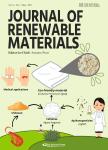版权所有:内蒙古大学图书馆 技术提供:维普资讯• 智图
内蒙古自治区呼和浩特市赛罕区大学西街235号 邮编: 010021

作者机构:Department of Agro-Industrial TechnologyUniversitas PadjadjaranBandung45363Indonesia Reseach Collaboration Center for Biomass and BiorefineryBRIN and Universitas PadjadjaranBandung45363Indonesia Department of Forest Product TechnologyFaculty of ForestryUniversitas Sumatera UtaraMedan20355Indonesia School of Life Sciences and TechnologyInstitut Teknologi BandungBandung40132Indonesia Department of Forest ProductsFaculty of Forestry and EnvironmentIPB UniversityBogor16680Indonesia Institute of Wood Technology and Renewable MaterialsDepartment of Material Sciences and Process EngineeringUniversity of Natural Resources and Life SciencesVienna3430Austria Research Center for Biomass and BioproductsNational Research and Innovation AgencyCibinong16911Indonesia
出 版 物:《Journal of Renewable Materials》 (可再生材料杂志(英文))
年 卷 期:2025年第13卷第4期
页 面:773-798页
学科分类:082903[工学-林产化学加工工程] 08[工学] 0829[工学-林业工程]
基 金:funded by the Research Collaboration Center for Biomass and Biorefinery Universitas Padjadjaran and BRIN Indonesia Grant Number 2534/II.7/HK.01.00/5/2023 and B-723/II.7/HK.01.00/4/2024
主 题:Bio-adhesives nanocellulose cellulose nanocrystals wood-based composites
摘 要:Nanocellulose-based adhesives are gaining attention as a viable alternative to conventional adhesives,offering benefits such as cost-effectiveness and scalability,which make them suitable for various sectors,including cosmetics,pharmaceuticals,biodegradable products,and as reinforcing agents in natural *** review delves into the current advancements in nanocellulose-based adhesive solutions for sustainable and eco-friendly wood composites,using systematic review methods and bibliometric *** were collected from the Scopus database,spanning from 2007 to 2024,and visualized using VOSviewer to highlight emerging trends in the *** analysis revealed that nanocellulose shows great potential as a reinforcing component for traditional adhesives used in wood products such as phenol-formaldehyde(PF),urea-formaldehyde(UF),polymeric diphenylmethane diisocyanate(pMDI),and melamine-urea ***,derived from the most abundant biopolymer,cellulose,has been utilized in its nanoscale form for adhesive *** review emphasizes the advancements in using cellulose nanocrystals(CNC)and cellulose nanofibrils(CNF)to develop sustainable *** explores both the challenges and future prospects for large-scale production and application of nanocellulose-based adhesives.